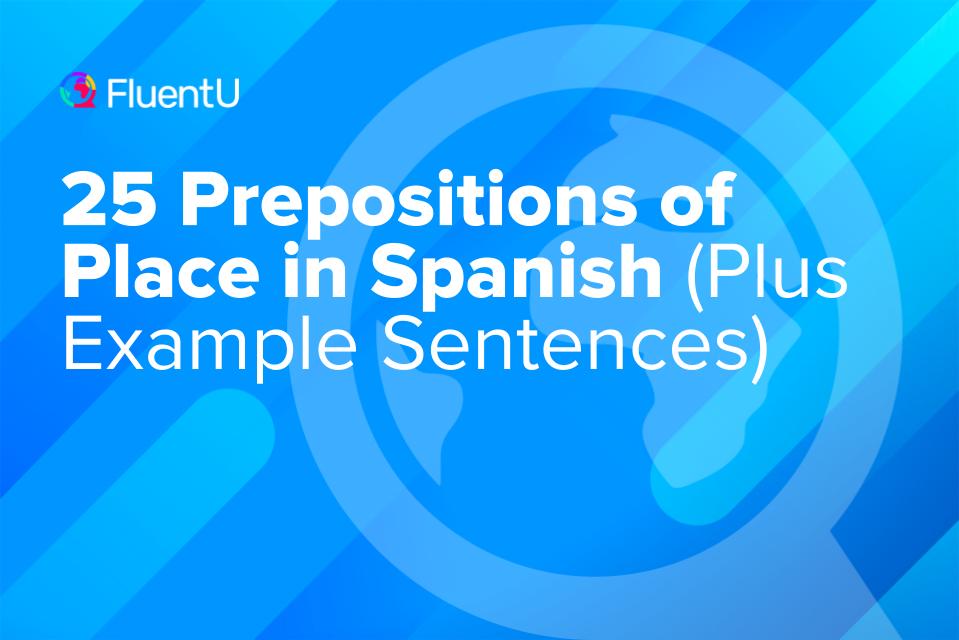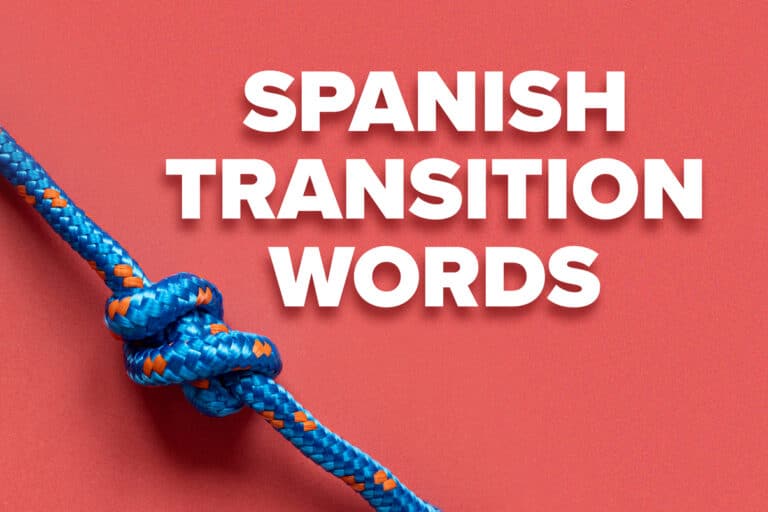Contents
- What Are Spanish Prepositions and How Do You Use Them?
- Spanish Prepositions of Place
- A (To)
- A la derecha de (To the right of)
- A la izquierda de (To the left of)
- A través de (Across, Through)
- Al lado de (Next to)
- Alrededor de (About, Around)
- Bajo (Under)
- Cerca de (Near)
- De (From)
- Debajo de (Under)
- Delante de (In front of)
- Dentro de (In, Inside, Within)
- Desde (From)
- Detrás de (Behind)
- En (In, On, At)
- Encima de (On top of)
- En frente de (In front of)
- En medio de (In the middle of)
- Entre (Between, Among)
- Fuera de (Outside, Out of)
- Hacia (Toward)
- Hasta ([Up] To, Until)
- Por (Around, By, Through)
- Sobre (On)
- Tras (Behind)
- How to Practice Spanish Prepositions of Place
- Bonus: Practice Quiz
- And One More Thing…
25 Prepositions of Place in Spanish (Plus Example Sentences)

Spanish prepositions of place like debajo de (under) show you where something exists or is happening.
These small words are an important part of the language, and using them can add meaning and clarity to your Spanish conversations.
Read on to find 25 essential prepositions of place in Spanish, as well as some useful practice resources!
Download: This blog post is available as a convenient and portable PDF that you can take anywhere. Click here to get a copy. (Download)
What Are Spanish Prepositions and How Do You Use Them?
So what exactly are Spanish prepositions?
As mentioned above, a preposition is a word that indicates information about location, place or movement. It also provides a link between different parts of sentences.
Prepositions commonly show a spatial (relating to place) relationship but can also indicate time relationships, too.
A preposition generally goes before nouns or pronouns in sentences. It shows where an item is or when an event occurred, often in relation to another item or event (“I’m on top of the world!”).
I’m sure you’re familiar with prepositions like within, toward, on and under. Those prepositions are used all the time when we speak English. And they’re used when we speak Spanish, too!
Understanding de and del
Before we go on, here’s a special note about a very useful Spanish word: de (of, from) is a multi-purpose preposition. It may be the most commonly used preposition because it’s used both alone and in conjunction with other prepositions.
You might notice that some of the prepositions in our list below actually use del instead of de. Del is a contraction that means “of the”/“from the” and it’s formed by combining de and the definite article el (the). This is used to indicate something is of, from or in some cases even about or by something.
Let’s see what prepositions of place we’ve got available to us—and check out how they’re used!
Spanish Prepositions of Place
Below, you’ll find some of the most common prepositions of place in Spanish with example sentences.
A (To)
Ella fue a la tienda. (She went to the store.)
Remember that when placed before a masculine word, a turns into al in the same way that de turns into del:
Ella fue al banco. (She went to the bank.)
A la derecha de (To the right of)
El gato está a la derecha del perro. (The cat is to the right of the dog.)
A la izquierda de (To the left of)
El león está a la izquierda del perro. (The lion is to the left of the dog.)
A través de (Across, Through)
El vaquero cabalgó a través del desierto. (The cowboy rode across the desert.)
Al lado de (Next to)
La escuela está al lado del hospital. (The school is next to the hospital.)
Alrededor de (About, Around)
Caminamos alrededor de la cuadra. (We walked around the block.)
Bajo (Under)
Nos sentamos bajo la sombra de un árbol. (We sat under the shade of a tree.)
Cerca de (Near)
Mi auto está cerca de un parque. (My car is near a park.)
De (From)
Él es de España. (He’s from Spain.)
Estoy a dos metros de la entrada. (I’m two meters away from the entrance.)
Debajo de (Under)
You can also use abajo de .
Las focas juegan debajo del agua. (The seals play under the water.)
Delante de (In front of)
You can also use adelante de .
Cantamos delante del público. (We sang in front of the crowd.)
Dentro de (In, Inside, Within)
You can also use adentro de .
Estamos dentro de la tienda. (We’re inside the store.)
Desde (From)
¿Desde dónde saldrá nuestro avión? (Where will our plane depart from?)
Detrás de (Behind)
You can also use atrás de .
El perro está escondido detrás de ese árbol. (The dog is hiding behind that tree.)
En (In, On, At)
We have several different prepositions when we talk about location within limits, like “in,” “on,” or “at.” In Spanish, however, you can use en in (almost) every case where you would need either of those three in English. Take a look at the examples below:
Me quedaré en el auto. (I will stay in the car.)
Las llaves están en la mesa. (The keys are on the table.)
Me aburro cuando estoy en casa. (I get bored when I’m at home.)
Encontré la información en Internet. (I found the information on the internet.)
Encima de (On top of)
El gato se duerme encima del armario. (The cat sleeps on top of the closet.)
En frente de (In front of)
Sometimes you may find this preposition being spelled enfrente de. Both spellings are acceptable. You can also use frente a .
Hay una fábrica en frente de mi casa. (There is a factory in front of my house.)
En medio de (In the middle of)
Construyeron una casa en medio de la nada. (They built a house in the middle of nowhere.)
Entre (Between, Among)
Encontré una carta entre esos dos libros. (I found a letter between those two books.)
Hay un espía entre los invitados. (There’s a spy among the guests.)
Fuera de (Outside, Out of)
You can also use afuera de .
Quiero ir fuera de la ciudad. (I want to go out of the city.)
Hacia (Toward)
Caminamos hacia la banca. (We walked toward the bench.)
Hasta ([Up] To, Until)
No nos detendremos hasta Toledo. (We won’t stop until Toledo.)
Disculpe, ¿este tren va hasta Córdoba? (Excuse me, does this train go to Cordoba?)
Por (Around, By, Through)
Don’t confuse this use of the word por (by, through) with por (for)!
Los alumnos caminaban por la biblioteca. (The students walked around the library.)
Estaré por la entrada. (I’ll be by the entrance.)
El gato se metió por la ventana. (The cat got in through the window.)
Sobre (On)
We use sobre for objects on surfaces, just in the same way we use “on”:
Hay una mosca sobre la pared. (There’s a fly on the wall.)
We can also use en for cases like these, though:
Tras (Behind)
El ladrón ahora está tras las rejas. (The burglar is behind bars now.)
How to Practice Spanish Prepositions of Place
Now that you’ve got an assortment of prepositions available to pull into your Spanish program, you’ll want to get some practice time in.
There are great resources to help you get your prepositions in order. And the best part is that they’re fun to work with. Let’s check them out!
- Wyzant quiz: This multiple-choice quiz has pictures to help you complete the sentences with the correct prepositions. The quiz itself is entirely in Spanish so you’ll get to practice reading and comprehension skills, too.
- FluentU: Sometimes, the best way to understand a particular bit of a language is to see it used by native speakers. FluentU, for example, has an array of Spanish videos that can help you see how prepositions are used in context.
FluentU takes authentic videos—like music videos, movie trailers, news and inspiring talks—and turns them into personalized language learning lessons.
You can try FluentU for free for 2 weeks. Check out the website or download the iOS app or Android app.
P.S. Click here to take advantage of our current sale! (Expires at the end of this month)

- Quizlet flashcards: Flashcards are a quick, uncomplicated tool that allow learners to squeeze practice time into busy schedules! These Quizlet flashcards are sure to help you get all your prepositions in order.
- SpanishBoat.com quiz: On this website, you’ll be able to find a variety of online Spanish exercises, including a couple of quizzes that can help you practice Spanish prepositions of place.
- Teachers Pay Teachers worksheet: This useful preposition worksheet is free to download.
- YouTube video: If you’re still fuzzy on your prepositions, YouTube it! This video by FluencyProf is fun, fast and it’ll clear up any lingering questions you might have about these important parts of the Spanish language.
Bonus: Practice Quiz
If you’d like to practice some of the prepositions of place that have been covered in this post, try completing these sentences with the missing prepositions!
1. Mi pasaporte está _______ una funda _______ mi mochila. (My passport is inside a case in my backpack.)
2. El lápiz que está _______ la mesa es _______ Pablo. (The pencil that is on the table is Pablo’s. [Literally: The pencil that is on the table is of Pablo.])
3. El perro está _______ la mesa y el gato está _______ la casa. (The dog is under the table, and the cat is out of the house.)
4. Caminamos _______ la plaza, _______ la tienda. (We were walking around the square, near the store.)
5. No puedo encontrar mi móvil. Lo dejé _______ la mesa _______ mis llaves. (I can’t find my cellphone. I left it on top of the table next to my keys.)
6. Viajaremos _______ Madrid _______ Toronto. (We’ll travel from Madrid to Toronto.)
Answers:
1. adentro de/dentro de, en
2. en/sobre, de
3. abajo de/bajo/debajo de, afuera de/fuera de
4. por/alrededor de, cerca de
5. encima de, al lado de
6. de/desde, a/hasta
Once you master the fine art of using Spanish prepositions of place to show where things are, your language skills will take on a whole new layer of meaning.
Prepositions explain where we—and everything around us—are. And knowing how to do that skillfully is a talent that takes some time and practice but will certainly make you stand out from the crowd.
And okay, so maybe there’s really nothing new under the sun, like the old adage says. But we can always take something old and make it fresh and exciting!
¡Buena suerte! (Good luck!)
Download: This blog post is available as a convenient and portable PDF that you can take anywhere. Click here to get a copy. (Download)
And One More Thing…
If you've made it this far that means you probably enjoy learning Spanish with engaging material and will then love FluentU.
Other sites use scripted content. FluentU uses a natural approach that helps you ease into the Spanish language and culture over time. You’ll learn Spanish as it’s actually spoken by real people.
FluentU has a wide variety of videos, as you can see here:

FluentU brings native videos within reach with interactive transcripts. You can tap on any word to look it up instantly. Every definition has examples that have been written to help you understand how the word is used. If you see an interesting word you don’t know, you can add it to a vocab list.

Review a complete interactive transcript under the Dialogue tab, and find words and phrases listed under Vocab.

Learn all the vocabulary in any video with FluentU’s robust learning engine. Swipe left or right to see more examples of the word you’re on.

The best part is that FluentU keeps track of the vocabulary that you’re learning, and gives you extra practice with difficult words. It'll even remind you when it’s time to review what you’ve learned. Every learner has a truly personalized experience, even if they’re learning with the same video.
Start using the FluentU website on your computer or tablet or, better yet, download the FluentU app from the iTunes or Google Play store. Click here to take advantage of our current sale! (Expires at the end of this month.)








